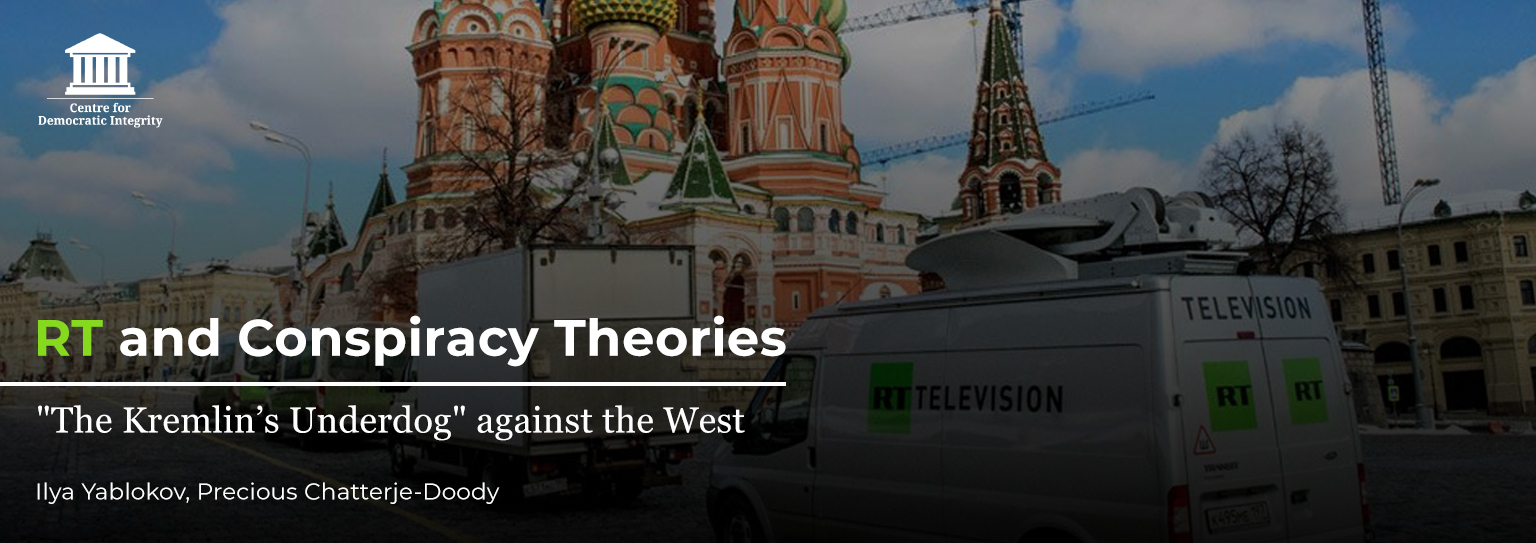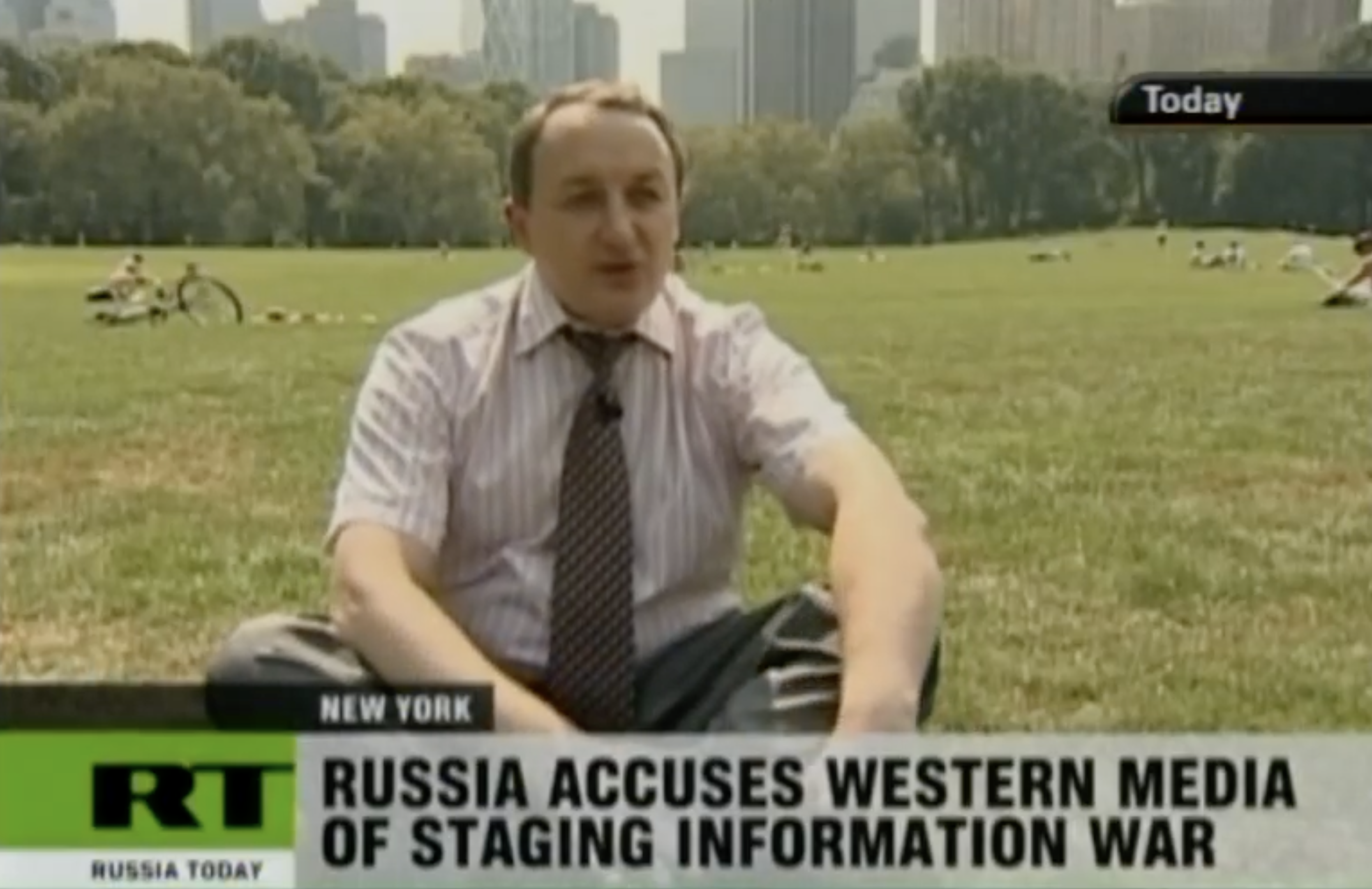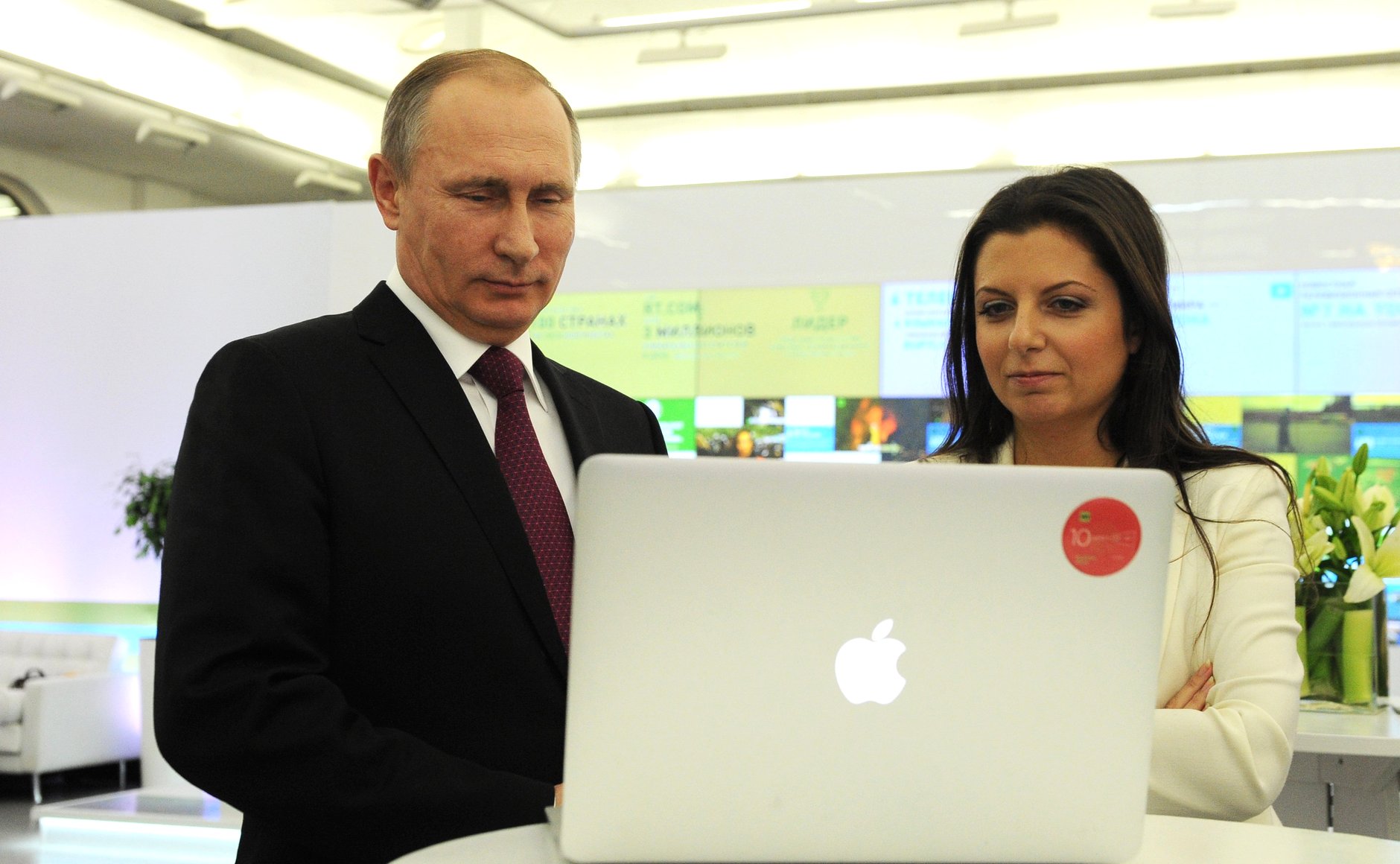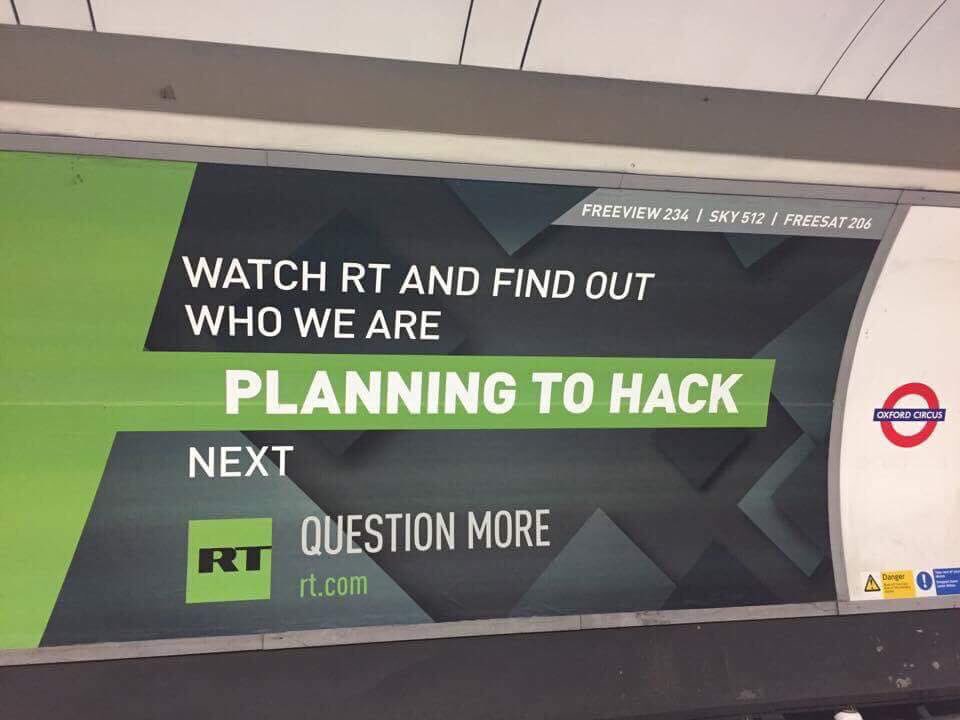
RT and Conspiracy Theories: “The Kremlin’s Underdog” against the West
Ilya Yablokov, Precious Chatterje-Doody
[This article is part of our publication project “RT in Europe and beyond”]
Why RT?
If you open a web page of the English-language version of RT, perhaps one of the first things you are going to see is a barrage of anti-US/UK/EU posts and news. Some look balanced, but others read like a political activist’s blog that takes sides and vigorously attacks an opponent. If you go further, into the op-ed section, you will find plenty of stories that can fairly be called conspiracy theories. These are RT’s specialty: whatever happens in the world, RT’s staff writers and columnists find the angle that will directly or indirectly connect societal and political problems with corporate crimes, the CIA’s plots around the world and the super-rich who work hand-in hand with the US government. Yet, RT was not always as critical of the West as it is now.

The channel was initially launched under the name “Russia Today” in 2005 as a traditional soft power tool to promote Russian culture,1 but its evolution began from a regional conflict in Georgia in 2008. In August 2008, the channel failed to defend Russia’s geopolitical interests during a conflict where pro-Russian forces annexed two regions of the republic of Georgia. Most of the global media covered this conflict from the Georgian perspective, calling the Russian military forces “the occupants” and blaming Moscow for starting the New Cold War.2 That summer, the Kremlin lost the global battle of words and completely changed their approach. The channel was rebranded as RT, received a massive financial boost from the Russian government and started an aggressive campaign of criticising transnational corporations, governments, global media holdings and US military expansionism.3 More importantly, the channel’s management put the idea of the conspiring “Other” into the channel’s broadcasting strategy. Among daily news and talk shows, a viewer was able to find regular publication of conspiracy fears that became a part of the channel’s brand identity.
Why conspiracy theories?
RT represents an excellent case for the investigation of how global communication technologies influence the development and dissemination of conspiracy theories; and what this means for conflict resolution when information cannot be sealed behind state borders or linguistic limitations. When the idea to write a book on RT and conspiracy theories came to one of the authors of this article in 2013, the channel was already growing as an international broadcaster interested in fringe opinions and alternative facts.4 This was before the catchphrase “fake news” was added to the daily vocabulary of both average news consumers and academics.5 A decade ago, RT pioneered the use of controversial opinions (packaged as freedom of speech), alternative facts, conspiracy theories and unverified claims as part of the news agenda to damage political opponents of the Kremlin on both sides of the Atlantic. The choice of questionable stories like conspiracy theories is not surprising: they help undermine the legitimacy of political and social actors and spread rapidly thanks to global communications, thus affecting and shaping opinions and biases of millions of people around the world.6

What does a regular conspiracy theory do? It questions the conventional order of people’s actions by looking “behind the curtains” to find a plot and nefarious masterminds who aim to destroy the status quo and render the lives of ordinary people miserable. Conspiracy theories help to explain the complicated reality around us: a world that lacks transparency and is full of inequality and injustice. At times, as Peter Knight notes,7 conspiracy theories can be onto something, but mostly they will be very far from reality. For RT presenters and guests, conspiracy theorising is the chance to show themselves as champions of the freedom of speech. Hence, the motto: “You can call me a conspiracy theorist, but I do my own research and just ask questions!” is an opening for an unrestrained speech and gives the floor to further, much more bizarre speculations that travel via a variety of media platforms.
Although conspiracy theories have been with us for centuries, it is the 20th and the 21st centuries that turned them into an integral part of the world’s perception.8 One of the outcomes of the Cold War is the idea of the dangerous Other that is threatening the stability of society. This is the idea that was equally popular in the US, the USSR and European countries involved in ideological battles.9 In the aftermath of the Cold War, the habit of finding the dangerous Other resumed, yet the image of dangerous masterminds became much more developed and richer.10 Throughout the post-Cold War period the images of conspiring enemies became part of the popular culture spread through songs, art and cinema.11 It is almost impossible to avoid a conspiratorial interpretation of any major news story or political development. Conspiracy theories are haunting us daily, and they will not go anywhere in the foreseeable future. However, the biggest impact that conspiracy theories have is on global political divisions where these ideas become part of populist platforms.
Why populism?
When reading RT, an attentive viewer will notice a recurrence of populist utterances. This is no coincidence. Populism has been referred to as a “thin-centred ideology” that political actors can map onto any specific ideological concerns they have, from either end of the political spectrum.12 In practical terms, though, populism often involves exploiting particular issues at times of real or perceived crisis and societal dissatisfaction.13 For this reason, several scholars look at populism in terms of what it actually does, i.e. as “a political logic”, a “style” of performing and thus enacting social relations or, most recently, as a “communication logic” which incorporates an actor’s claims, motives and methods of engagement.14 Broadly speaking, populist appeals tend to mobilise “the people” against power-holding “elites” who are depicted as corrupt, self-serving and out of touch with “ordinary” citizens’ problems.15 Conspiracy theories are built precisely around this opposition between “the people” and a scheming “elite”. They represent a populist interpretation of how power works: powerful elites serve their own interests at the expense of the public.16 Indeed, studies have shown that openness to the populist values of people‐centrism and anti‐elitism is associated with a more positive perception.17 What is more, belief in any conspiracy theory increases openness to other such ideas, regardless of whether they fit coherently together.18
After the defeat in 2008, RT has superbly weaponised a populist agenda (with ideas taken from both the Right and the Left) and turned it into one of its brand elements. The shapeshifting of RT aimed to turn it into the “underdog” whose mission was to speak on behalf of the “people” (everyone threatened by the first world states’ governments and companies) about the crimes committed by elites in the West. Ideally, that meant finding stories in the US, UK and other European countries.

In 2010, Margarita Simonyan, RT’s chief editor, said: “Everybody wants to know what is happening in their backyards […] We decided […] to look for stories that are on the one hand extremely interesting, that can be breath-taking, fascinating for our audience, and on the other hand that have not been reported or [are] hugely underreported in the mainstream media”.19 That combination was supposed to bring a greater audience to the stories allegedly unreported by the so-called “mainstream media”, which would often be very critical of the US and Western European governments. Moreover, that approach is based on two premises: first, that “people […] understand that the whole truth cannot be told by Anglo-Saxon television channels”.20 And secondly, that “there is no objectivity: there are as many approximations of the truth as there are potential voices”.21 The populist division of the world between the “power elite” (the US and others) and the “underdog” (Russia) would help to spread misinformation and mistrust in the states that are the Kremlin’s future opponents. However, the populist agenda is one of the few fundamentals of RT’s strategy that employs conspiracy theories.
What is unique about RT’s media strategy?
RT’s entrance to the global media market coincided with a decrease in trust of various institutions, including the media. People became more trusting of alternative figureheads that allowed media outlets like RT to spread all sorts of stories that, as they claim, “mainstream media” would ignore.22 Conspiracy theories, due to their attractiveness and divisive character, would be the first on RT’s list. At the same time, many people would consume and trust alternative interpretations of current news more than other available sources. So, the truth is separated from analysis of public records, debate and consensus-building. Instead, credibility attaches itself to the “new type of heroic truth teller” who is “brave enough to call bullshit on the rest of the establishment”.23 RT has occupied precisely that niche: an underdog truth-seeker that is able to speak truth to the world, exposing the corruption, lies and deception of the ruling class.
RT’s brand identity is therefore built on its capacity to raise questions, rather than providing any detail or credible answers. This practice, which RT has developed over time, makes conspiratorial insinuations rather than outright allegations. The purpose of RT is to curate favourable opinions in the news agenda whilst keeping itself distant from what the guests say. These guests can be affiliated journalists, no-name bloggers or retired intelligence officers. RT says that its mission is to provide the floor to all viewpoints, some of which are often ignored by “mainstream media”. By posing as an alternative to the “mainstream media”, RT not only brands itself to attract potential viewers and followers of such content, it also seeks to show that traditional media is dead and the road is open for all sorts of non-conventional approaches to news and current affairs.
On the technical side, airing conspiracy theories can be problematic: some governments can strip the licence from those media outlets that are engaged in the spread of misinformation. RT has fallen into that trap several times in the UK, causing an investigation by the media watchdog Ofcom.24 Therefore, RT’s staff became tech-savvy when it comes to airing unverified claims.

During the Skripal affair in 2018, when a former Russian double agent and his daughter were poisoned by a bioweapon, RT was desperate to find the holes in the narrative developed by the British government and intelligence, while simultaneously avoiding breaking the Ofcom regulations and losing their broadcasting licence. RT’s staff, via talk shows, op-ed pieces and news reports, covered multiple conspiracy theories produced by other authors and media entities, accusing the UK government, investigative journalists, the military and scientists of staging the coup to accuse Russia of the murder attempt. Most of the Skripal-related stories were mutually conflicting, but the goal was to chip away at the credibility of the official accounts that had been released to the public about the poisonings and stay within the legal limits. When it was difficult to find the one convincing voice to spread favourable views on the Skripal poisoning, RT used social media posts to create content for their news stories and attracted a disproportionate amount of air time to such stories. Relying on social media posts and outsourcing some of the most blatant accusations into the op-ed section helped RT protect itself from possible legal consequences. RT also used access to public information about the police investigation to cast doubt on the UK government’s actions, and shared conspiratorial tweets by Russian officials to provide weight to the questionable allegations against the UK officials’ line.

Usually, an uninformed viewer will not notice that RT is a Russian-funded television channel. RT as a brand is slick enough to have plenty of attention on all continents. Rather than give the Kremlin’s perspective on events, it invites audiences to “Question more” about the news. The point here is not to tell audiences what the Kremlin thinks, but to reinforce its status as an outsider that shows that no one can be fully trusted. RT only engages in aggressive pro-Russian news-making when the Kremlin’s policy line is at stake. In fact, RT is a product of, and a savvy player in, a broader global media environment. The context for RT’s evolution is vital because today’s communication is not a one-way process: news coverage is a product of the interactions of journalists, host platforms and audiences. All of these elements contribute to the ways in which populist messages are constructed and developed. Together, they work to give conspiratorial online content a comparative circulatory advantage. Positioning itself as an outside voice, RT chose conspiracy theories as its key content. They have become, in a way, part of RT’s identity.
How can conspiracy theories be instrumentalised?
As an example, let us look at the most recent international stories that RT’s staff picked up for airing: the global COVID-19 pandemic and the 2020 US Presidential elections.

At the start of the global pandemic in March 2020, while many US media outlets were broadcasting cautious messages about self-isolation and social distancing, RT’s hosts were actively spreading false narratives. They laughed at the “mainstream media” and called the pandemic the type of stories that the media love.25 Within a couple of weeks, as countries were closing borders around the world, including Russia, RT changed its approach and called for social distancing in their programmes. At the same time, the hosts used every opportunity to attack corporations and governments for not providing help to the most vulnerable social groups. Even in stories with no conspiratorial content, RT’s hosts were able to find or create these. In one of the shows, Jesse Ventura, presenter of “The World according to Jesse”, spoke about the media criticism of Tesla’s founder Elon Musk for delivering a different kind of ventilator to California hospitals.26 Ventura’s response to the story boiled down to the traditional RT mantra of the big oil lobby in control of the media that used every opportunity to challenge Musk’s electric cars. “The oil business hates him” concluded Ventura.27 RT only once openly engaged with a COVID-related conspiracy theory entitled “The Great Reset”. This is the notion that the global elite will turn the post-pandemic world into a “digital concentration camp” where ordinary people would be divided into classes based on their vaccination status and surveyed 24/7.28
On the contrary, the op-ed section can be called a repository for all sorts of COVID-related conspiracy theories, from anti-vaxxers and government-critical extreme libertarians, precisely because RT can hide behind the principle: “The statements, views and opinions expressed in this column are solely those of the author and do not necessarily represent those of RT”. Up to today, RT’s website has accumulated hundreds of pieces written by covid-dissidents that see the disease and the vaccination programme as the “health pass tyranny” of the globalist government.29 The lockdown policies are portrayed as the way for governments to suppress freedom of speech. Some argue that legitimate worries about the efficiency of anti-COVID measures were being portrayed as wacky conspiracy theories by scientists and the media, in ways reminiscent of communist-era psychological treatment of ideological opponents.30

The US presidential elections provided a brilliant opportunity for RT to air many allegations about the US political system, which was portrayed in disarray and vulnerable to flaws.31 RT implicated both of the main political parties in this hijacking of the democratic process, and the sentiment recurs in no uncertain terms throughout RT’s op-eds, even those not about the elections. There is the idea that those in “the elite” or “the Establishment” “believe democracy has gone too far”, and have “little genuine love for democracy” when it brings to power those with populist views with which they do not sympathise.32 For the most part, both candidates were represented as interchangeable defenders of a militaristic and persistent status quo, past their prime and driven by similar corporatist and fascistic tendencies; and their parties represent neither the interests of voters, nor the US as a whole.33 Articles sympathetic to Trump painted him as the victim of an all-encompassing establishment conspiracy. The Democratic Party was portrayed as being corrupt and dangerous.34 Leading Democrats were subject to character assassination, and many of RT’s op-eds covered conspiracy theories related to Hunter Biden and his business dealings, even repeating Trump’s words in referring unironically (and without inverted commas) to “the Biden crime family”.35 As late as 9 November 2020 op-eds were referring in delegitimising tones to the “apparent victory” of Biden, as merely a return to the establishment’s warmongering business as usual, the “Great Reset” of global capitalism and the “new pathologized totalitarianism”.36
What can be done?
Perhaps the biggest question for policy makers and experts is: what can be done with the conspiratorial narratives pushed by RT that decrease public safety and trust in expert knowledge?
First, RT might be a pioneer of some broadcasting tactics but it is not unique in its efforts to spread misinformation, and legislative measures on reporting falsehoods seem to be effective. These measures should be applied consistently and treat every media outlet equally. The market incentives for clickable content mean that policy responses must be addressed towards the whole (multiplatform) environment, rather than focussed on one actor within it (therefore, statements like “RT is a propaganda bullhorn” are not efficient and in turn legitimise many of RT’s “underdog” claims). Such regulation must encompass statutory duties of broadcast media and social media platforms, a clarification of the responsibilities of content producers versus hosts, and cross-sector collaboration, plus transnational intergovernmental coordination of penalties for non-compliance.
Secondly, most conspiracy theories spread online and offline because people tend to overestimate their critical thinking abilities. A variety of media literacy programmes should target different social and age groups to foster understanding of the complexity of the digital and global communication environment.
Thirdly, media platforms like RT benefit from the conflicts within society – corruption, infringements committed by political elites, lack of political transparency and socio-economic polarisation – and here lies the hardest part. Conspiracy theories will inevitably arise as part of the socio-economic context in every society, and there will always be the outlet who tries to promote such views for their own benefit. It is vital to spare too much criticism of such outlets and instead focus on the long-term goal to safeguard political and media institutions and protect citizens’ capacity to productively engage with them.
See also: How Russian Media Targeting International Audiences Spread Conspiracy Theories, an online discussion co-organised by the Centre for Democratic Integrity and forum journalismus und medien on 26 May 2020
Endnotes
1. Sergey Varshavchik, “Zhenskoe litso propagandy”, Nezavisimaya gazeta, 8 August (2005), https://www.ng.ru/politics/2005-06-08/2_propaganda.html.
2. Dali Osepashvili, “Covering of Russian-Georgian August 2008 War in Time Magazine”, Conference of the International Journal of Arts & Sciences, Vol. 3, No. 2 (2011), pp. 31-38.
3. “Pravitel’stvo RF prinyalo perechen’ sistemoobrazuyushchikh predpriyatiy”, RBK, 25 December (2008), https://web.archive.org/web/20081228023521/http:/top.rbc.ru/economics/25/12/2008/271243.shtml.
4. Ilya Yablokov, Precious Chatterje-Doody, Russia Today and Conspiracy Theories: People, Power and Politics on RT (London: Routledge, 2021).
5. Kiril Avramov, Vasily Gatov, Ilya Yablokov, “Conspiracy Theories and Fake News”, in Michael Butter, Peter Knight (eds), Routledge Handbook of Conspiracy Theories (London: Routledge, 2020), pp. 581-595.
6. Ilya Yablokov, Fortress Russia: Conspiracy Theories in the Post-Soviet Space (Cambridge: Polity, 2018).
7. Peter Knight, Conspiracy Culture: From Kennedy to The X Files (London: Routledge, 2000).
8. See a collection of articles on various aspects of conspiracy theories in Butter, Knight (eds), Routledge Handbook of Conspiracy Theories.
9. Kathryn Olmsted, Real Enemies: Conspiracy Theories and American Democracy, World War I to 9/11 (New York: Oxford University Press, 2009); Yablokov, Fortress Russia; Andreas Önnerfors, André Krouwel (eds.), Europe: Continent of Conspiracies: Conspiracy Theories in and about Europe (London: Routledge, 2021).
10. Knight, Conspiracy Culture; Mark Fenster, Conspiracy Theories: Secrecy and Power in American Culture (Minneapolis: University of Minnesota Press, 2008); Jack Z. Bratich, Conspiracy Panics: Political Rationality and Popular Culture (Albany: State University of New York Press, 2008).
11. Megan Garber, “The Paranoid Style in American Entertainment”, The Atlantic, 14 May (2020), https://www.theatlantic.com/culture/archive/2020/05/survivor-20-years-later-keeps-teaching-us-trust-no-one/610981/; Ronald Purser, “The Mindfulness conspiracy”, The Guardian, 14 June (2019), https://www.theguardian.com/lifeandstyle/2019/jun/14/the-mindfulness-conspiracy-capitalist-spirituality; Patricia A. Turner, I Heard It Through the Grapevine: Rumor in African-American Culture (Oakland: University of California Press, 1993); Robert Alan Goldberg, Enemies Within: The Culture of Conspiracy in Modern America (New Haven: Yale University Press, 2001).
12. Cas Mudde, Cristobal Rovira Kaltwasser, Populism: A Very Short Introduction (Oxford: Oxford University Press, 2017).
13. Margaret Canovan, “Populism for Political Theorists?”, Journal of Political Ideologies, Vol. 9, No. 3 (2004), pp. 241-252.
14. Ernesto Laclau, On Populist Reason (London: Verso, 2005); Benjamin Moffitt, Simon Tormey, “Rethinking Populism: Politics, Mediatisation and Political Style”, Political Studies, Vol. 62, No. 2 (2013), pp. 381-397.
15. Paul Taggart, Populism (Buckingham: Open University Press, 2000); William Davies, Nervous States: How Feeling Took over the World (London: Jonathan Cape, 2018).
16. Fenster, Conspiracy Theories; Yablokov, Fortress Russia.
17. Bruno Castanho Silva, Federico Vegetti, Levente Littvay, “The Elite Is Up to Something: Exploring the Relation between Populism and Belief in Conspiracy Theories”, Swiss Political Science Review, Vol. 23, No. 4 (2017), pp. 423-443.
18. Ted Goertzel, “Belief in Conspiracy Theories”, Political Psychology, Vol. 15, No. 4 (1994), pp. 731-742; Michael J. Wood, Karen M. Douglas, Robbie M. Sutton, “Dead and Alive: Beliefs in Contradictory Conspiracy Theories”, Social Psychological and Personality Science, Vol. 3, No. 6 (2012), pp. 767-773.
19. Andrew E. Kramer, “Russian Cable Station Plays to US”, New York Times, 23 August (2010), http:// www.nytimes.com/2010/08/23/business/media/23russiatoday.html.
20. Aleksandr Gabuev, “Net nikakoy ob’ektivnosti”, Kommersant-Vlast’, 7 April (2012), http://kommersant.ru/Doc/1911336.
21. Maxime Audinet, “RT, Russia’s Voice to the World”, Le Monde diplomatique, 8 April (20178), https://mondediplo.com/2017/04/08rt.
22. Stephen Coleman, “Introduction”, European Journal of Communication, Vol. 33, No. 2 (2018), pp. 117-121; Ilya Yablokov, “Conspiracy Theories as Russia’s Public Diplomacy Tool: The Case of ‘Russia Today’ (RT)”, Politics, Vol. 35, Nos 3-4 (2015), pp. 301-315.
23. Davies, Nervous States.
24. “Update on Investigations into the RT News Channel”, Ofcom, 20 December (2018), https://www.ofcom.org.uk/about-ofcom/latest/media/media-releases/2018/update-investigations-rt-news.
25. “Jimmy Dore & Rick Sanchez Destroy MSM’s New Red-baiting Campaign”, RT, 29 February (2020), https://www.rt.com/shows/the-world-according-to-jesse/481876-msm-russian-thread-us-politics/.
26. Jon Passantino, “Elon Musk Says He Sent Ventilators to California Hospitals, They Say They Got Something Else Instead”, CNN, 17 April (2020), https://edition.cnn.com/2020/04/17/tech/elon-musk-ventilators-california/index.html.
27. “US Workers Appeal to UN for Help”, RT, 9 October (2020), https://www.rt.com/shows/watching-thehawks/502911-us-firms-labor-law-violation/.
28. Graham Dockery, “Humans of the Great Reset: What the Future Might Look Like in 2021 – if the Controlling Elites Have Their Way”, RT, 3 January (2021), https://www.rt.com/news/510860-great-reset-future-society-predictions/.
29. Neil Clark, “Emmanuel Macron’s Covid ‘Health Pass’ Tyranny Reveals the True Extremism of Globalist Faux-Centrism”, RT, 16 August (2021), https://www.rt.com/op-ed/532205-covid-health-pass-macron/.
30. Helen Buyniski, “‘Conspiracy Theories’ on Covid-19 Come from Brain Damage? Questionable Science Is Being Used to Pathologize Real Dissent”, RT, 19 November (2020), https://www.rt.com/op-ed/507210-unscientific-paper-pathologize-dissent-miller/.
31. Vera Tolz, Vitaly Kazakov, “The US Presidential Election through a Russian Media Lens: From Domestic Legitimacy to Global (Mis)Information”, Reframing Russia, 24 November (2020), https://reframingrussia.com/2020/11/24/the-us-presidential-election-through-a-russian-media-lens-from-domesticlegitimacy-to-global-misinformation/.
32. Frank Furedi, “The Elite Say Too Much Democracy Is Undemocratic, but They Just Want to Stop the ‘Wrong Sort of People’ Winning Elections”, RT, 7 October (2020), https://www.rt.com/op-ed/502839-elitetoo-much-democracy/.
33. Slavoj Zizek, “Slavoj Zizek: Biden’s Just Trump with a Human Face, and the Two of Them Share the Same Enemy”, RT, 27 October (2020), https://www.rt.com/op-ed/504705-slavoj-zizek-biden-trump/; Helen Buyniski, “Black Panderers: Trump & Biden’s Fight for African American Vote Is a Grotesque Pantomime of Caring”, RT, 16 October (2020), https://www.rt.com/op-ed/503690-trump-biden-africanamerican-vote/.
34. Samantha Chang, “Reaction to Biden’s ‘Win’ Shows that Leftists Will Never Be Happy, because They Always Want to Play the Victim”, RT, 22 November (2020, https://www.rt.com/op-ed/507297-biden-win-leftistsplay-victim/.
35. Mitchell Feierstein, “‘He’s Back’: The Last Week Has Illustrated the MSM and Establishment Bias against Trump, but Despite That He’ll Still Win Election”, RT, 16 October (2020), https://www.rt.com/op-ed/502661-msm-establishment-trump-win/.
36. C.J. Hopkins, “The War Is Over … Global Capitalism Triumphs!”, RT, 10 November (2020), https://www.rt.com/op-ed/506307-warover-globocap-triumphs/.
